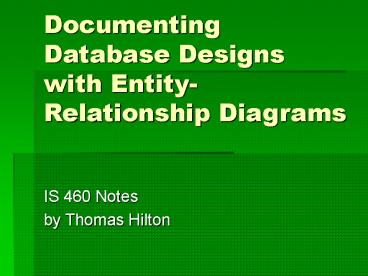Documenting Database Designs with Entity-Relationship Diagrams - PowerPoint PPT Presentation
Title:
Documenting Database Designs with Entity-Relationship Diagrams
Description:
Documenting Database Designs with Entity-Relationship Diagrams IS 460 Notes by Thomas Hilton What is the E-R Model? A method of conceptualizing and documenting data ... – PowerPoint PPT presentation
Number of Views:185
Avg rating:3.0/5.0
Title: Documenting Database Designs with Entity-Relationship Diagrams
1
Documenting Database Designs with
Entity-Relationship Diagrams
- IS 460 Notes
- by Thomas Hilton
2
What is the E-R Model?
- A method of conceptualizing and documenting data
structures used in organizations - Static, not dynamic (data, not process)
- Logical/conceptual, not physical
3
Essential Definitions
- a group of instances that share the
same attributes - a link between entities
- a simplified, abstract replica of
some real-world system
- Entity
- Relationship
- Model
Entity-Relationship Diagram
Entity Identification
Key/Attribute identification
Conversations, observations, forms, reports, etc.
Relationship Identification
Table Normalization
4
E-R Symbols
- No Fixed Standard, but Some Common Usage
- Maximum Cardinality1 or M (or a particular
number)If I have one of these, how many of
those can I have? - Minimum Cardinality0 or 1 (or a particular
number)If I have one of these, how many of
those must I have?
ENTITY
MaxMin
MinMax
5
Attributes
- Can be represented with a circle or ellipse on
the entity, but please dont for me - Instead do thisENTITY KEY-ATT,
REQ-NON-KEY-ATT, REQ-NON-KEY-ATT, Opt-non-key-att
6
Keys
- one or more attributes whose
values uniquely identify each instance in an
entity - attributes (or attribute
groups) which could function as primary keys - candidate keys not chosen as
the primary key - key consisting of more than
one attribute - one or more attributes whose
values identify groups of instances within an
entity - key replicated in two entities
to instantiate a relationship between them - common key which is primary in
one entity and secondary in the other
- Primary
- Candidate
- Alternate
- Composite
- Secondary
- Common
- Foreign
7
Attribute Constraints
- Instantiate Business Rules
- consistency
between entities (particularly common keys) - whats legal and whats not
(format, size, value ranges, etc.) - (external and)
internal consistency within the entity -
transactions, data sources, required approvals,
legitimate users, etc.
- Referential Integrity
- Domain
- Entity Integrity
- Triggering operations
8
Table Normalization
- Analyze entities into tables that can be
manipulated without data redundancy and the
resulting modification anomalies - splitting the attributes of one entity into
multiple tables - All non-key attributes must be fully
functionally dependent - on the key, 1NF (non-dependencies)
- the whole key, 2NF (partial dependencies)
- and nothing but the key. 3NF (transitive
dependencies)
- Definition
- Tool
- Rule
9
Domain-Key Normal Form
- Every constraint on the table is a logical
consequence of the table's domain constraints and
key constraints - Have one theme per table
10
Lets Do An Example!
11
Lets Do An Example!































